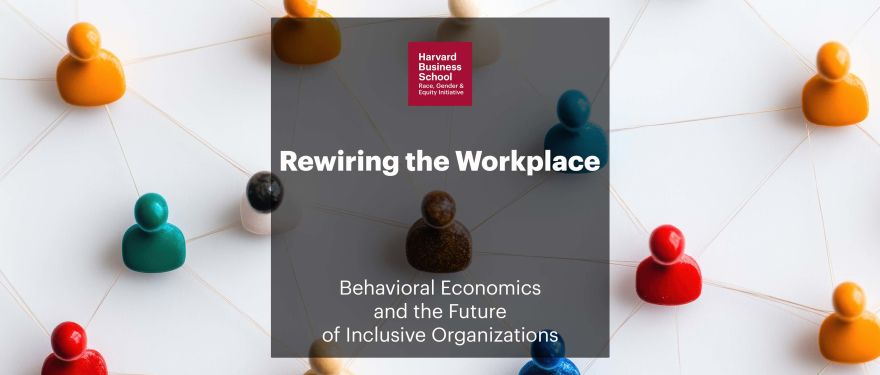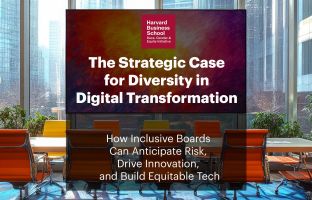In this edition of the RGE Report, we’ll discover how insights from behavioral economics can re-shape our workplaces. We examine research from HBS Professors John Beshears and Katherine B. Coffman and unpack key takeaways for closing gaps between majority and underrepresented groups.
This edition was developed in partnership with the Institute for Business in Global Society (BiGS), which conducted interviews with Professors Beshears and Coffman to better understand their research and its implications for workplace practices. Watch the interviews here:
Addressing systemic inequality is a complex, multifaceted, and often behemoth task that we attempt to tackle from multiple vantage points. Organizations often approach workplace equity as one of many discrete goals. In practice, however, alleviating the effects of inequities requires a shift in organizational culture, including fundamentally reworking value systems and decision-making frameworks to cultivate the best environment for the employees of all backgrounds.
In this edition of the RGE Report, we’ll discover how insights from behavioral economics can re-shape our workplaces. We examine research from HBS Professors John Beshears and Katherine B. Coffman and unpack key takeaways for closing gaps between majority and underrepresented groups.
Why do beliefs matter in decision-making?
Behavioral economics is both a subfield of economics and a framework through which to look at our society, specifically at the overlap between economic decisions and the psychology of decision-making. It is well-established that human beings are biased thinkers, and it is inherent to our nature to make decisions that are informed by heuristics or shortcuts, which can be shaped by socialized prejudices or misperceptions. The biases that appear in our decision-making processes present clear barriers to achieving equity that we can unpack through behavioral science.
A crucial example of how these biases manifest in barriers for underrepresented groups is stereotyping. Stereotypes are a feature of our belief systems, which are also intrinsic to our decisions. Findings from Professor Coffman’s latest research show us how beliefs about gender remain pervasive and persistent in hiring and promotional decisions. For example, male managers in particular are more likely to subconsciously implement discriminatory workplace practices that favor men, particularly if the job is in a male-dominated field. This phenomenon stems from gendered beliefs about women’s abilities and performance, which these male managers have internalized and thus inform their actions.
Further research from Professor Coffman shows us that not only do these stereotypes and beliefs affect how managers view their direct reports, but they also affect how we view ourselves. Another recent study demonstrates that women and men rate their own performance in accordance with their internalized beliefs. Women are taught to question themselves, and are likely to have internalized self-doubt about their own abilities. The study revealed that women underestimated their performance on a set of given tasks, while men overestimated their performance.
So, both of these studies show us that beliefs have a reciprocal effect between employee and employer, wherein both reinforce problematic stereotypes about themselves and others. Though these studies focused on gender, we may also extrapolate the findings to other marginalized groups that suffer from stereotype bias.
Play an active role in your choices.
So, how can we take these findings and apply them toward a more equitable workplace?
Research from Professor Beshears reveals that there are solutions we can apply to reconcile our beliefs with their decision-making outcomes. The choice architecture framework is a heuristic designed to alleviate the effects of beliefs, biases, and other behaviors that hinder our choices. This framework essentially repackages choices in a way that helps to circumvent biased thinking or decision-making inertia. This model, along with Professor Beshears’ principle of active choice, is relevant to biased decision-making because traditional choice often relies on defaults. When personnel decisions rely on defaulting, our biases will lead us to choose the person who we consider to be the default—in our society, this image looks like people who belong to dominant groups (white, male, heterosexual, etc.). If an organization can steer managers, employees, and even senior leaders toward active choices, this makes it hard for defaults to determine decisions and more likely that choices will be rooted in data, information, and a clear rationale.
An example, in which a large organization reframed the value proposition for diversity, is the case of the FTSE 100. The boards of these companies were initially skeptical of changing their recruitment process to include more gender diversity. To flip the script, the intervening agents—the non-profit 30% Club and the Davies Review—led a campaign to publicize the fact that 94% of boards already had some gender diversity, with at least one woman director. This framing repackaged gender diversity as an existing phenomenon, ostensibly lowering the risk of recruiting more woman directors moving forward. The intervention started with the board chairs of the FTSE 100 companies, with the U.K. government setting up a public target of increasing women’s representation on boards to 25%. As these 100 board chairs joined the charge and wielded their influence to garner momentum toward this goal, more chairs and directors were eager to take part, ultimately bringing about the anticipated boost in the percentage of women represented on FTSE.
Build collective power by leveraging undeniable value.
How can members of underrepresented groups fight for parity? We have outlined many lessons for leaders, but employees can also work to close gaps by illustrating that their labor is invaluable. This has historically been achieved through various means, but most often through collective bargaining. Professor Beshears’ case study on the U.S. Women’s Soccer Team’s fight for wage parity is a recent example of how collective bargaining created a major shift for gender-equal treatment. The U.S. Women’s team achieved their goal by surpassing their male counterparts, winning consistent international championships and solidifying their global brand, which provided them with enormous leverage in negotiating for pay parity with U.S. Men’s team. Collective power and an understanding of our own worth are key to making sure the fight for equity endures.







